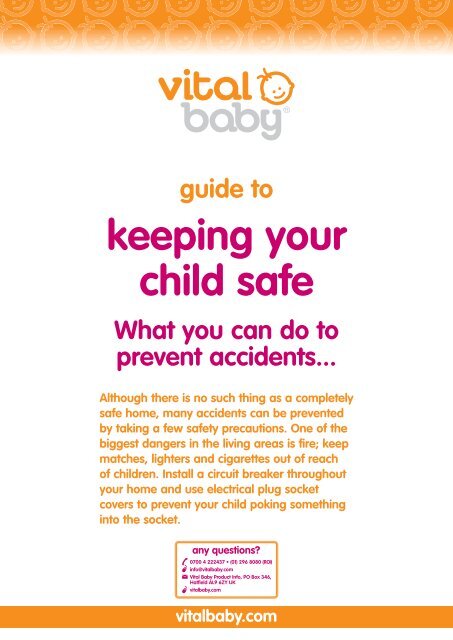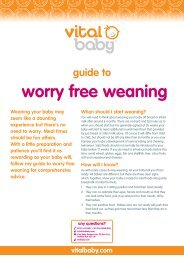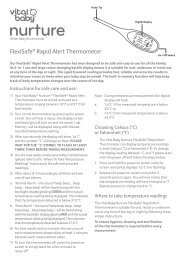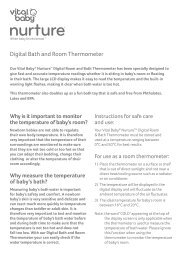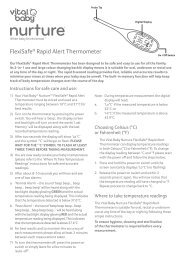Create successful ePaper yourself
Turn your PDF publications into a flip-book with our unique Google optimized e-Paper software.
guide to<br />
<strong>keeping</strong> <strong>your</strong><br />
<strong>child</strong> <strong>safe</strong><br />
What you can do to<br />
prevent accidents...<br />
Although there is no such thing as a completely<br />
<strong>safe</strong> home, many accidents can be prevented<br />
by taking a few <strong>safe</strong>ty precautions. One of the<br />
biggest dangers in the living areas is fire; keep<br />
matches, lighters and cigarettes out of reach<br />
of <strong>child</strong>ren. Install a circuit breaker throughout<br />
<strong>your</strong> home and use electrical plug socket<br />
covers to prevent <strong>your</strong> <strong>child</strong> poking something<br />
into the socket.<br />
any questions?<br />
0700 4 222437 • (01) 296 8080 (ROI)<br />
info@vitalbaby.com<br />
<strong>Vital</strong> <strong>Baby</strong> Product Info, PO Box 346,<br />
Hatfield AL9 6ZY UK<br />
vitalbaby.com<br />
vitalbaby.com
hall, stairs and landing<br />
• The most common accident is a <strong>child</strong> falling down the<br />
stairs. Fix gates at the top and bottom of the stairs to<br />
prevent <strong>child</strong>ren having access to them.<br />
• Ensure that there are no loose floor coverings or any<br />
trailing wires.<br />
• Make sure that stair carpet is securely fitted and in a good<br />
state of repair.<br />
• Gaps between stair spindles should be no more than<br />
10cm/4in so that a <strong>child</strong>’s head<br />
• Check that the lighting is good so that there is no risk of<br />
tripping on unseen objects on the stairs.<br />
• Fit <strong>safe</strong>ty film or <strong>safe</strong>ty glass to any glass doors in these<br />
areas.<br />
• Make sure that the front-door latch and letterbox are out<br />
of reach.<br />
• Ensure there is a smoke alarm fitted and regularly tested.<br />
living rooms<br />
• Try looking at the room from <strong>your</strong> <strong>child</strong>’s level (e.g. on <strong>your</strong><br />
knees). Frequent <strong>safe</strong>ty checks are need as the danger<br />
areas change as <strong>your</strong> <strong>child</strong> becomes more mobile.<br />
• Fit all fires with guards<br />
• Unplug electric fires when they are not in use.<br />
• Make sure that all fabrics and upholstery are made from<br />
fire-resistant materials.<br />
• Fit <strong>safe</strong>ty protectors to the corners of cupboards and<br />
tables.<br />
• Use mats instead of tablecloths so that <strong>your</strong> <strong>child</strong> can’t pull<br />
things off the table on top of him.<br />
• Place mugs/cups of hot drinks well away from baby’s<br />
reach.<br />
• Place all ornaments and breakables out of reach.<br />
• Make sure that the floor is clean and that there are no<br />
small objects that could be swallowed.<br />
kitchen<br />
• The most common accidents in the kitchen are scalds<br />
from hot water, burns from cookers and poisoning from<br />
cleaning products.<br />
• Keep the doorway blocked with a <strong>safe</strong>ty gate.<br />
• Put all sharp objects, such as knives, well out of reach.<br />
• Fit <strong>safe</strong>ty catches to all low-level cupboards, drawers, the<br />
fridge and also the freezer.<br />
• Use a shortened coiled kettle flex.<br />
• Cook on the back rings of the hob with the pan handles<br />
facing inwards.<br />
• Use a pan guard on the cooker.<br />
• Never leave containers of hot liquid or cups of tea where<br />
<strong>your</strong> <strong>child</strong> can reach them.<br />
• Make sure that all household chemicals and cleaning<br />
materials are out of reach and that their lids are tightly<br />
secured.<br />
bathroom<br />
• Scalds from hot water, falls in the bath or shower,<br />
poisoning from medicines and cuts from razors, scissors<br />
and broken glass are the most common accidents in the<br />
bathroom.<br />
• Keep all medicines and other dangerous objects, such<br />
as razors locked away in a cabinet and out of reach of<br />
<strong>child</strong>ren.<br />
• Use a non-slip bathmat in the bath to prevent slipping.<br />
• Fit a lock to the toilet seat.<br />
• Make sure <strong>your</strong> <strong>child</strong> cannot reach the window by<br />
climbing on the toilet or the bath.<br />
• Always run cold water into the bath before adding hot<br />
water and check the temperature before putting <strong>your</strong> <strong>child</strong><br />
in the tub.<br />
• The water temperature should not be above 32°C/90°F.<br />
• Hang a towel over the taps to prevent a <strong>child</strong> burning<br />
herself.<br />
• Check that <strong>your</strong> <strong>child</strong> cannot reach the door lock and lock<br />
herself in.
<strong>your</strong> <strong>child</strong>’s bedroom<br />
• This is the one room where <strong>your</strong> <strong>child</strong> will spend time<br />
alone so regular <strong>safe</strong>ty checks are essential as <strong>your</strong> <strong>child</strong><br />
grows and becomes more adventurous.<br />
• Make sure that <strong>your</strong> baby’s cot and mattress conform to<br />
<strong>safe</strong>ty standards and that the mattress fits snugly into the<br />
cot base.<br />
• If <strong>your</strong> <strong>child</strong> sleeps in a bed, always use a bed barrier and<br />
make sure there is a <strong>safe</strong>ty gate fitted at the top of the<br />
stairs.<br />
• Use a nursery light or dimmer to give <strong>your</strong> <strong>child</strong><br />
reassurance at night and to allow you to look in on her<br />
without causing any disturbance.<br />
• Monitor <strong>your</strong> <strong>child</strong> in bed by installing a nursery listening<br />
device<br />
• Keep a check on the temperature by placing a<br />
thermometer in the bedroom, which needs to be around<br />
18°C/65°F.<br />
• Try to keep <strong>your</strong> <strong>child</strong> protected from cigarette smoke,<br />
which could put them at risk from coughs, chest infection<br />
and even cot death.<br />
• Fit any windows with locks.<br />
• Make sure you place the cot or bed away from the<br />
window.<br />
outside<br />
• Many accidents happen outside the home. Even if you<br />
have <strong>your</strong> own garden never leave a young <strong>child</strong> outside<br />
on his own.<br />
• Keep all garden tools and chemicals locked away.<br />
• Fit locks to garden sheds and garage doors.<br />
• Make sure that any gates leading to the road are secure.<br />
• Always use a harness, reins or wrist link when you are out<br />
on the pavement with <strong>your</strong> <strong>child</strong>.<br />
• Make sure that the surface under any play equipment is<br />
<strong>safe</strong> for <strong>child</strong>ren to fall on.<br />
• Cover up any ponds or water butts.<br />
equipment<br />
• Ensure that any equipment you buy conforms to the <strong>safe</strong>ty<br />
regulations established by the European Union (EU) and<br />
the British Standards Institute (BSI).<br />
• Only use equipment for the age of the <strong>child</strong> it has been<br />
designed for.<br />
• Second-hand equipment needs to be checked thoroughly<br />
for <strong>safe</strong>ty.<br />
• Use <strong>safe</strong>ty straps when you put <strong>your</strong> baby in a pram,<br />
pushchair, highchair or bouncing cradle.<br />
• Never put a bouncing cradle on a table or raised surface<br />
as <strong>your</strong> baby’s movements could easily make it fall off.<br />
• When travelling in a car always put <strong>your</strong> baby in a car seat<br />
approved for the <strong>child</strong>’s weight and age.<br />
• Use <strong>child</strong> locks on doors<br />
• Don’t leave <strong>your</strong> <strong>child</strong> alone in the car even if she is firmly<br />
strapped into her seat.


